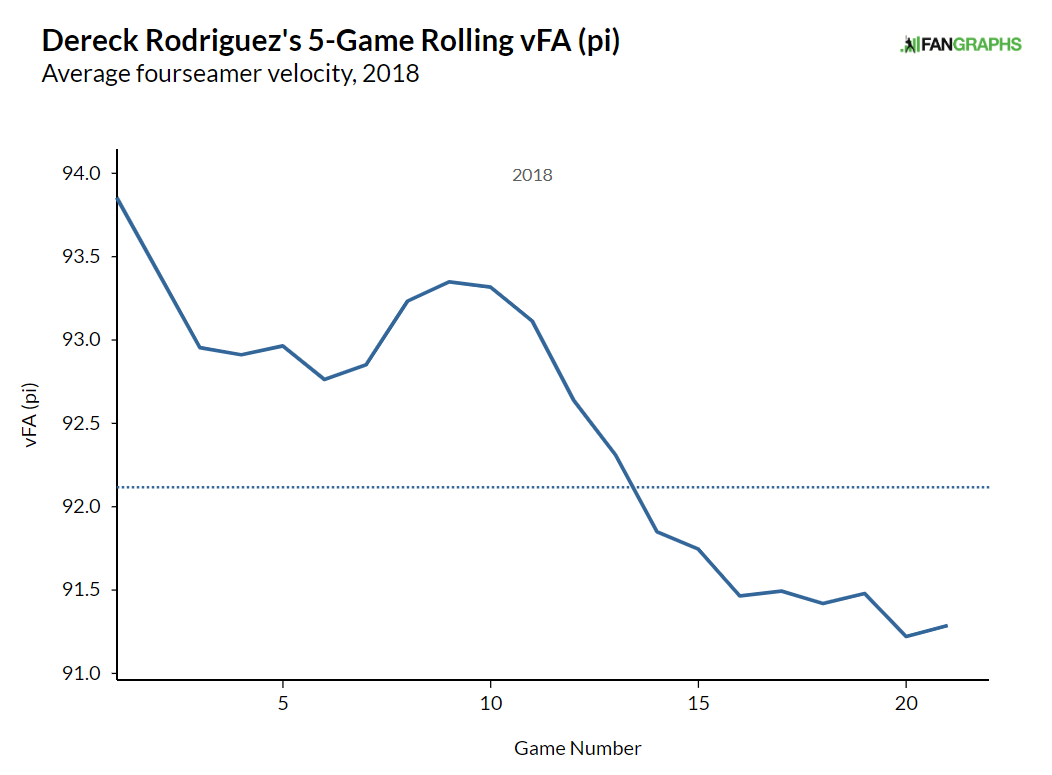Before this past season, Dereck Rodriguez hadn’t garnered much attention. The attention he did receive was baseball-related, but it didn’t have much to do with his skills as a player. For one, Rodriguez is a second-generation major leaguer. His father is Hall of Fame catcher Iván Rodriguez. Secondly, the younger Rodriguez was a hitter himself—until he wasn’t. After spending three years in the minor leagues as a hitter in the Minnesota Twins system, he converted from an outfielder into a pitcher.
That makes Rodriguez one of the more successful players to have transitioned from pitcher to hitter, and vice versa. At least for now. When you glance at his numbers, they aren’t overwhelming. His 2018:
| IP | K-BB% | HR/9 | ERA- | xFIP- | SIERA |
| 118.1 | 10.9% | 0.68 | 72 | 112 | 4.58 |
Of pitchers with more than 110 innings, Rodriguez ranks:
- 18th in ERA-
- 98th in K-BB%
- 113th in xFIP
- 103rd in SIERA
By ERA, Rodriguez has performed well. He was one of the best starting pitchers at limiting runs. That’s good, but many would argue that this isn’t at all sustainable. His K-BB% isn’t good. His xFIP- isn’t good. His SIERA—you guessed it!—isn’t good. His HR/9—which is low, so I suppose you could call it good—is a statistic that is neither stable nor predictive, and if it had regressed toward league average (as it did in his minor league days), Rodriguez’s 2018 ERA would not have been as pristine as it is.
For 2019, Steamer predicts Rodriguez will perform more in line with his peripherals. To be exact, it has Rodriguez posting a 4.44 ERA and 0.8 WAR over 159.0 innings. The projection is reasonable enough. Rodriguez ranked around 100th in K-BB%, xFIP, and SIERA, while the one metric in which he stands out, ERA-, is also of the least importance.
There aren’t many good pitchers with Rodriguez’s profile, and there are few—if any—who are elite. For example, Jon Lester is fine, and Jhoulys Chacin is too, but pitchers with profiles that resemble Rodriguez’s are more likely to look like, say, 2018 Felix Hernandez than 2014 Hernandez. As with most players, there are things about Rodriguez that aren’t as apparent when glancing at statistics like xFIP or SIERA. The obvious first thing to delve into is whether anything about him changed throughout the year. To that, I answer with a resounding, “Yes!” One hundred times yes!
On August 14, the Giants and Dodgers had themselves a brawl. I don’t mean figuratively speaking, but I also don’t necessarily mean literally, as it was only a brawl in the sense that any bench-clearing fracas in baseball is a “brawl.” Yasiel Puig and Nick Hundley exchanged a push and some words, benches cleared, and then there was a lot of angry pointing and hypermasculine posturing. Mostly, though, there was standing. It’s hard to tell in the video where Rodriguez got mixed up in all of this, but he went on the disabled list with a Grade 1 hamstring strain two days later, and it was reportedly as a result of this silly altercation.
It’s hard to assign causality to this injury because there are many factors that go into pitching, but Rodriguez was different after he returned from the DL.
| K-BB% | HR/9 | ERA- | xFIP- | SIERA | |
| Pre-injury | 14.4% | 0.45 | 58 | 98 | 4.12 |
| Post-injury | 4.2% | 1.17 | 102 | 141 | 5.53 |
This isn’t a perfect way to look at this. Pre-injury Rodriguez pitched 80 innings, while post-injury Rodriguez had thrown just 38.1. They aren’t equal samples, nor are they large samples to begin with. This could be the consequence of adjustments from hitters, injury, or fatigue—and I imagine it’s some combination of all three—but there was one more important factor.
Rodriguez’s fastball velocity in 2018:

To start the year, Rodriguez was sitting above 93 mph. By the end, his fastball was dipping below 90 mph. In general, it’s optimal to have your best fastball. Surely that is obvious. A difference of 3 mph on your fastball is vast in general, but it is monumental when you’re working in the lower 90s. For someone who converted to pitching five years ago, this is even more important, as his secondary pitches are understandably still a work in progress.
What’s interesting about Rodriguez is that by spin rate and velocity, his fastball shouldn’t be very good. Here is a scatter plot, courtesy of Baseball Savant, laid out by four-seam fastball velocity and spin rate:

You’ll find Rodriguez labeled as the red dot, and at the very least, you can say his fastball is weird. It has the eighth-lowest spin rate in this sample, and if you’re curious, the names in his vicinity are Jose Quintana, Jakob Junis, and Andrew Suarez—not exactly aces. Rodriguez’s fastball is a touch below 92 mph, and his spin rate is effectively 2,000 rpm. For the purposes of the following chart, we’ll go ahead and say his fastball is 92 mph with 2,000 rpm.
Real cool from @jeffwzimmerman: SwStr% on FB, spin v velo. For Ks, high everything is good. https://t.co/AgRrLLl66W pic.twitter.com/crmT4Ajump
— Mike Petriello (@mike_petriello) September 12, 2016
Fastballs with Rodriguez’s combination of velocity and spin rate have a swinging-strike percentage of 5.2. That’s not good! Rodriguez’s fastball, however, is good.
After Rodriguez had pitched 30 innings, Jeff Zimmerman of FanGraphs took a look at him. What caught my eye about Rodriguez, and what Zimmerman raved about, was that at the time, Rodriguez possessed a 14.0% SwStr% with his four-seam fastball. Shortly thereafter, as these things often go, Rodriguez’s fastball fell by the wayside. Through June 27, his four-seam SwStr% was 15.7%. As Zimmerman notes, that’s more than two times the average rate for fastballs. From that point through the end of the year, his fastball’s swinging-strike percentage fell to a more ordinary rate of 8.9.
Even though his fastball lost some effectiveness, over the course of the year it still grades out well. By xwOBA, his fastball ranks 73rd, and by exit velocity, it ranks 80th. That may not sound great, but for one, there’s a lot of relievers in the data pool because he didn’t pitch the entire year. Secondly, it simply is good. His xwOBA for his fastball is a couple of points better than Noah Syndergaard’s and Gerrit Cole’s, and his average exit velocity for his fastball is tied with Justin Verlander and just behind dominant fastball pitchers like Blake Snell, Patrick Corbin, Luis Severino, and Charlie Morton.
Maybe hitters adjusted. Maybe his lessened velocity started to hamper him. Or maybe there’s even more to it.
My first instinct was that Rodriguez was tunneling well, or maybe he had a deceptive delivery. After some digging, I found that Eno Sarris of The Athletic had talked to him specifically about pitch tunneling. There’s a lot of encouraging tidbits. First, Rodriguez speaks about pairing an elevated four-seamer with his curveball. They tunnel well together. Previously, I had found Rodriguez’s increasing sinker usage to be problematic. As it stands, it’s easily his worst pitch—but he’s using it with intention in order to become a more complete pitcher. While the four-seamer pairs well with his curveball, his sinker is better suited for his other secondary offerings. This lends credence to the argument that Rodriguez is skilled at mixing his pitches and doing his best to make hitters uncomfortable and guessing as often as possible. When you lack elite velocity and movement like Rodriguez, it’s imperative to compensate in other areas, a la noted soft-tosser (and fellow enigma) Jamie Moyer.
It isn’t easy to understand what makes bat-to-ball pitchers successful. Most players don’t outperform their peripherals, but many do. There are reasons to believe Rodriguez could do the former, and there are reasons to think he could also do the latter.
Of pitchers with 300 or more results, he ranks as follows on batted balls:
- 11th in xwOBA (.325)
- 11th in wOBA (.315)
OK, so Rodriguez is elite when hitters put his pitches in play. But what about in general? Of pitchers with 400 results:
- 47st in xwOBA (.297)
- 31st in wOBA (.289)
Not as good, but still good! On batted balls, Rodriguez has an xwOBA that is a point better than Trevor Bauer’s, and an actual wOBA just five points worse than Blake Snell’s. Sure those names are cherry-picked to an extent, and you could pick players that sound far worse (Wei-Yin Chen? Anibal Sanchez, maybe?), but when it comes to batted balls, he is just outside of top 10 in both expected and actual wOBA. The contact he’s giving up is favorable, incredibly pitcher-friendly, and his wOBA and xwOBA are closely aligned.
On the other hand, xStats’ expected statistics aren’t as encouraging for Rodriguez compared to Baseball Savant’s. Here is a table with numbers pulled from xStats in which Rodriguez’s actual numbers and expected numbers are compared, along with league-average numbers:
| OBP | SLG | BABIP | BACON | wOBA | |
| Actual | .291 | .376 | .259 | .278 | .290 |
| Expected | .322 | .411 | .303 | .321 | .317 |
| League average | .318 | .409 | .296 | .327 | .315 |
The easy way to explain this table is that Rodriguez’s actual numbers were great, but across the board, his expected numbers are league average. While Baseball Savant has his expected wOBA at .296, xStats has it at .317, which is considerably worse. That’s the difference between being Rich Hill and Tanner Roark.
It would be silly to not see any regression coming. A 2.81 ERA is difficult to maintain, even for the best. The Yankees traded for a difference-maker in James Paxton, and he’s coming off a 3.76 ERA season. Pitching is hard, and it’s not always all that predictable.
The easy thing to do is to write Rodriguez off. Pitchers overperform all the time, and surely he’s not different! All of the metrics say to stay away, and yet the more you look, the more he seems like an exception. Rodriguez throws five pitches—and not all of them are workable yet—but there’s a lot of room for growth. 2019 will be just Rodriguez’s sixth year pitching, and there’s a lot of uncertainty as to what is happening. Velocity was lost, injuries were had, his sample isn’t big, and his profile isn’t blowing anyone away. What’s important is Rodriguez has shown the ability to induce weak contact, and it appears that it’s as a result of how he’s utilizing his pitches with intention. It feels like the least saber-savvy thing I could say, but even though the peripherals are unimpressive, the aggregate of what I’ve found have me believing he’s more legitimate than what is presented by his ugly xFIP and SIERA. And that is to say, legitimate enough.
(Photo by Bob Kupbens/Icon Sportswire)

